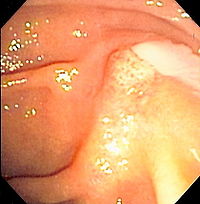
Photo from wikipedia
BackgroundThe optimal approach at treating infected biliary stents at the time of cholangitis remains unknown. This study aims to compare the efficacy of stent exchange versus stent sweeping/stent-in-stent approaches at… Click to show full abstract
BackgroundThe optimal approach at treating infected biliary stents at the time of cholangitis remains unknown. This study aims to compare the efficacy of stent exchange versus stent sweeping/stent-in-stent approaches at treating cholangitis.MethodsThe study was a retrospective cohort study. Patients with biliary stents and cholangitis were included. Outcomes were rate of recurrent cholangitis and time to recurrent cholangitis in those whose stents were left in place (stent sweeping and stent-in-stent) compared to those whose stents were removed (stent exchange). Primary analysis included patients with metal biliary stents only. Secondary analysis included those with metal and plastic biliary stents.ResultsA total of 182 patients (age 64 ± 12;89 F) with a metal biliary stent(s) at index cholangitis were included. Of these, 40 (22%) had stents removed, i.e., stent exchange. The remaining 142 (78%) did not have stent removal (97 with stent-in-stent and 45 with stent sweeping). Recurrent cholangitis occurred in 22.5% and 42.3% in the stent removal and non-removal groups, respectively (p = 0.02). Stent removal remained a negative predictor of recurrent cholangitis after controlling for age, sex, history of diabetes, and chemotherapy (OR 0.39, p = 0.03). Median time from index cholangitis to recurrent cholangitis was shorter for patients whose stents were not removed compared to those whose stents were removed (182 vs 450 days, p = 0.011). On Cox regression model, stent removal remained a negative predictor of recurrent cholangitis after controlling for age, sex, history of diabetes, and chemotherapy (HR 0.41, p = 0.01). The findings persisted in the secondary analysis including both metal and plastic biliary stents (303 patients).ConclusionBiliary stent removal with stent exchange at the time of cholangitis appears to be more effective at preventing recurrent cholangitis than leaving an infected stent in the biliary system.
Journal Title: Surgical Endoscopy
Year Published: 2019
Link to full text (if available)
Share on Social Media: Sign Up to like & get
recommendations!